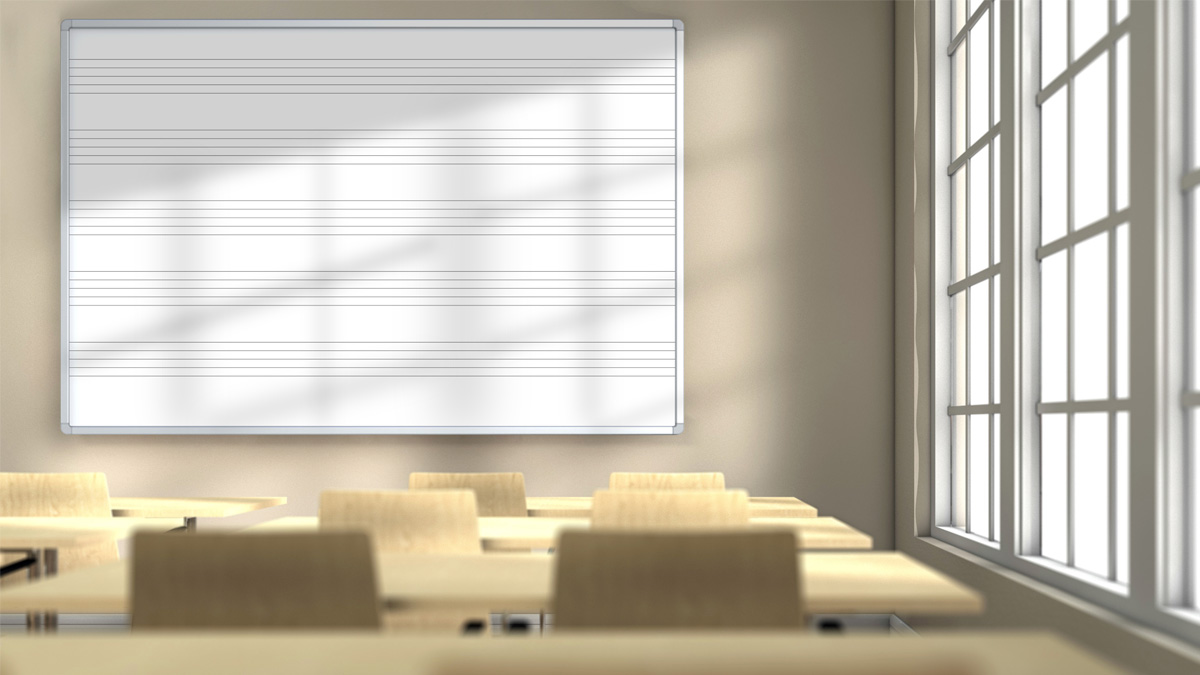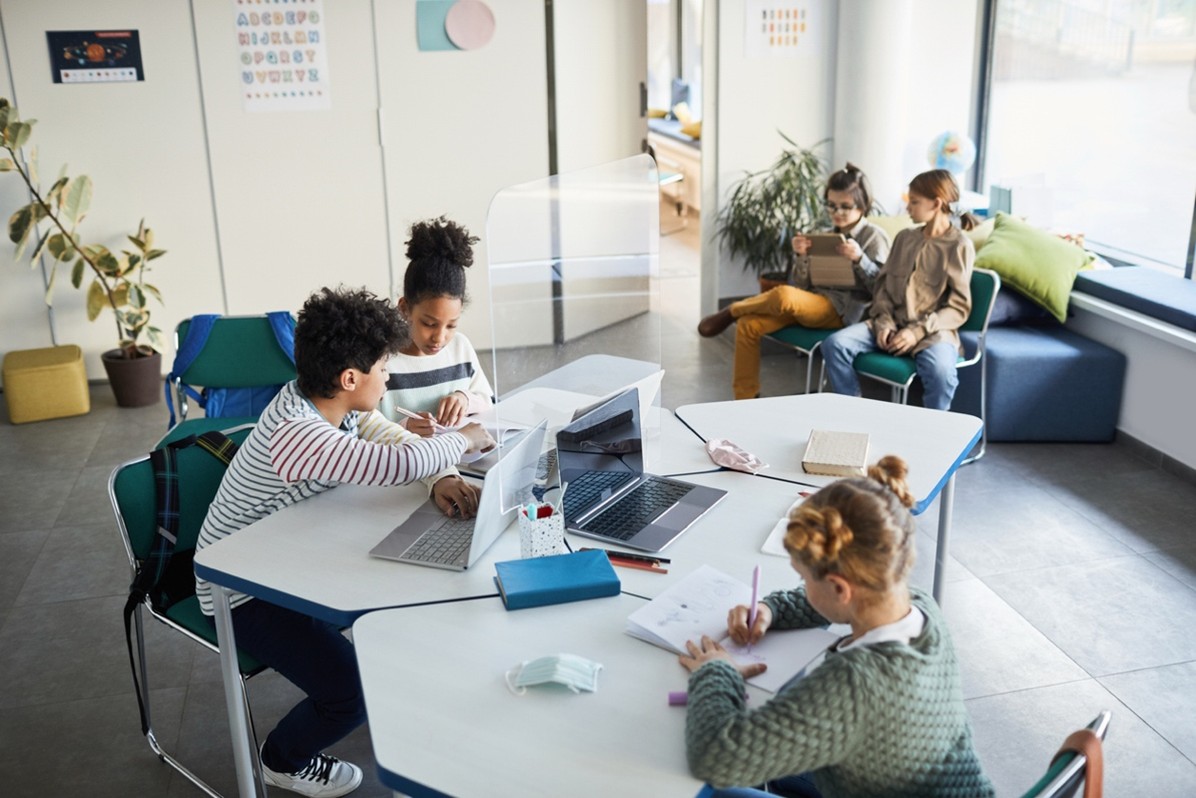This article explores how intentional classroom design, emphasizing joyful aesthetics and flexible learning spaces, can enhance students’ emotional well-being and academic performance, ultimately equipping them with the confidence and skills necessary to succeed in a dynamic world.

In today’s rapidly changing educational landscape, the focus is shifting from traditional rote learning to creating environments that inspire joy and foster confidence. School district leadership is instrumental in designing classrooms that nurture these qualities to transform educational spaces into vibrant communities where students thrive.
Specific design elements that contribute to joyful and empowering learning environments, such as using color and light, flexible spaces, nature integration, and art displays can support academic success and cultivate a love for learning and personal growth.
Designing for Joy
Joyful learning environments are not just about aesthetics. They are about creating spaces where students feel safe, supported, and engaged. According to Ingrid Fetell Lee, author of Aesthetics of Joy, design elements can significantly impact students’ emotional and cognitive experiences. Bright colors, natural light, and flexible seating arrangements can transform a classroom into a dynamic learning hub. These elements stimulate positive emotions and enhance students’ readiness to learn.
One exemplary model is The Joy School in Houston. Nestled in the city’s museum district, this unique institution serves students with learning differences from kindergarten through eighth grade. Its mission is to equip these students to return to traditional classrooms, empowered with the academic and social skills they need to succeed.
The Joy School’s approach provides valuable insights into how classroom environments can be designed to promote joy and confidence in all students and how joyful, and confidence-building environments can be created in practice. By focusing on students’ strengths and providing a supportive, vibrant learning space, the school transforms struggling students into enthusiastic learners.
Teachers at The Joy School use innovative strategies, such as multisensory learning and social-emotional development, to address each child’s unique needs. The school’s design supports these strategies by offering flexible learning spaces, sensory-friendly areas, outdoor learning spaces, and interactive and personalized learning environments that reflect the diverse needs of its students.

This holistic approach prepares students academically and instills the confidence they need to thrive in traditional educational settings. The Joy School’s success demonstrates the powerful impact of thoughtful design and individualized support in fostering student growth and well-being.
While The Joy School is a strong example, other institutions have also embraced design principles that foster joy and confidence. Brightworks School in San Francisco uses a project-based learning approach with flexible, adaptable learning spaces that promote creativity and collaboration. Similarly, Reggio Emilia Schools in Italy emphasize the environment as the “third teacher,” where classrooms are designed to be interactive and reflect children’s interests and learning processes.
These schools exemplify how learning environments can be tailored to support student engagement and motivation. According to the HundrED article, “Schools that prioritize joyful design see an increase in student motivation and a decrease in absenteeism.”
Key Design Elements to Inspire Joy
Critical design elements that inspire joy in educational spaces—such as color and light, flexibility, and nature and art integration—can improve student engagement, motivation, and overall well-being.

1. Color and Light
Use vibrant colors and natural light to create a warm and inviting atmosphere. Colors can influence mood and behavior; for example, blues and greens are calming, while yellows and oranges can energize and inspire creativity. Proper use of color and light can create an inviting atmosphere that stimulates learning.
How to Implement
-
Color Choices: Select colors based on the desired mood for each space. Use blues and greens in areas meant for relaxation and focus, like libraries or reading nooks. Use yellows and oranges in creative spaces like art rooms or brainstorming areas to stimulate energy and creativity.
-
Paint and Accessories: Use vibrant colors for walls, furniture, or decorative accents. Consider feature walls in brighter hues while keeping the rest of the room in neutral tones to balance the environment.
-
Lighting: Maximize natural light by positioning desks and seating near windows. Use sheer curtains to diffuse harsh sunlight while maintaining brightness. Choose fixtures with adjustable settings for artificial lighting to mimic natural light cycles throughout the day.
Research from the Journal of Environmental Psychology indicates that exposure to natural light in classrooms is linked to improved student performance and mood, reinforcing the importance of lighting in educational settings.
2. Flexible Spaces
Adaptable spaces that can be rearranged for different activities support diverse learning styles and needs. Movable furniture allows for collaboration, group work, and individual study, increasing student engagement and motivation.
How to Implement
-
Movable Furniture: Invest in lightweight, modular furniture that can be rearranged easily. Look for items like folding tables, stackable chairs, and mobile whiteboards.
-
Zoning: Use rugs, screens, or shelves to create zones within larger rooms, allowing for different activities such as group work, individual study, or relaxation.
-
Multi-Purpose Areas: Design spaces that can serve multiple functions, such as a classroom that can be used for workshops or events by simply rearranging furniture.
A study published in Learning Environments Research found that classrooms with flexible seating arrangements increased student engagement by 16% compared to traditional settings. This study involved a diverse group of students and highlighted how flexible designs cater to varied learning preferences and lead to improved participation and enthusiasm.
3. Nature Integration
Incorporating natural elements like plants and outdoor views reduces stress and increases focus. Nature has a soothing effect and raises students’ well-being and productivity.
How to Implement
-
Indoor Plants: Incorporate a variety of plants, such as succulents or ferns, which are low-maintenance and improve air quality. Use vertical gardens or hanging planters to save space.
-
Natural Materials: Use wood, stone, or bamboo furniture and decor to create a natural feel. Incorporate natural textures through textiles like wool or cotton.
-
Outdoor Views: Position workspaces to take advantage of views of gardens, trees, or green spaces. If possible, create outdoor classrooms or learning areas.
A study published in Frontiers in Psychology found that students exposed to natural elements in classrooms had a 13% higher attention span than those in conventional settings. This supports integrating nature into learning environments to reduce stress and increase focus.
4. Art and Creativity
Allowing students to personalize their space with artwork and projects fosters a sense of ownership and pride, boosting confidence and motivation.
How to Implement
-
Art Displays: Dedicate wall space for students to display artwork and projects. Use corkboards, magnetic boards, or clip systems for easy updates.
-
Creative Supplies: Provide access to art supplies like paints, markers, and crafting materials and encourage students to create personal items for their space.
-
Workshops and Clubs: Organize art workshops or clubs to inspire creativity and allow students to explore different mediums and techniques.
Building Confidence Through Design
By linking joyful design with confidence-building strategies, educators can create spaces that support students’ growth and self-assurance.
Fostering confidence through classroom design involves creating environments that encourage exploration, resilience, and a positive mindset. Incorporating adaptive spaces, personalized learning zones, and supportive layouts empowers students to take risks, engage deeply, and embrace the learning process enthusiastically.
1. Growth Mindset through Adaptive Spaces
Encouraging a growth mindset involves creating a classroom that supports experimentation and flexibility. Flexible spaces with movable furniture can adapt to various learning activities, allowing students to experiment with different learning styles. For example, lightweight, modular furniture lets students rearrange their environment to accommodate group work, presentations, or individual study. This adaptability teaches students to view challenges as opportunities for growth rather than threats to their self-esteem.
At Brightworks School in San Francisco, classrooms are equipped with movable furniture and adaptable spaces that allow students to transition seamlessly between individual work and group projects. This flexibility supports a growth mindset by encouraging students to explore different approaches to problem-solving.
2. Personalized Learning in Diverse Environments
Personalized learning can be enriched by designing classrooms that cater to individual interests and needs. Incorporating zones for different activities—such as quiet reading areas, collaborative workspaces, and creative studios—enables students to choose where they feel most comfortable and focused. Color choices and decor can also reflect the diversity of student preferences, creating an inclusive environment that recognizes individual strengths. When students see that their unique needs are acknowledged, they feel valued and empowered.
The Joy School in Houston tailors its classroom environments to the specific needs of its students, incorporating sensory-friendly areas and individualized learning stations. This personalized approach helps students build confidence by providing a supportive space where they can thrive.
3. Safe Environment with Thoughtful Layout
A safe and supportive classroom culture begins with a layout that facilitates positive interactions and open communication. Arranging desks in a circle or U-shape encourages dialogue and ensures every student feels seen and heard. This setup, linked with clear pathways and accessible resources, fosters an environment where students feel secure to express themselves and take risks. Establishing spaces where students can share their work, such as art display walls, further encourages them to take ownership of their learning journey.
At Reggio Emilia Schools in Italy, classrooms are designed with circular seating arrangements and open spaces that promote interaction and collaboration. This layout creates a sense of community, safety, and confident engagement between peers and teachers.
4. Positive Feedback and Inspirational Surroundings
The physical environment can reinforce positive feedback by visually celebrating student achievements. Displaying student work prominently in the classroom boosts self-esteem and serves as a constant reminder of students’ capabilities and progress. Integrating inspirational quotes and visuals to emphasize resilience and growth motivates students to embrace continuous learning and improvement.
In many classrooms, teachers create “achievement walls” where students’ work and accomplishments are showcased alongside motivational quotes. This practice boosts confidence and encourages students to take pride in their efforts and contributions.
Creating classrooms that promote joy and confidence requires intentional design and a commitment to adopting a positive school culture. School district leadership can spearhead this transformation by prioritizing student-centered environments that celebrate diversity, encourage creativity, and build resilience. By learning from models like The Joy School, incorporating insights from various schools and studies, and embracing innovative design principles, schools can become places where students excel academically and develop a lifelong love of learning.
This article is based, in part, on the following articles:
- https://hundred.org/en/articles/can-we-design-our-schools-to-inspire-joy-and-increase-learning
- https://teachbetter.com/blog/learning-environments-that-exude-joy/
- https://aestheticsofjoy.com/design-a-better-school/
- https://www.edutopia.org/article/4-ways-classroom-design-impacts-executive-functioning/









